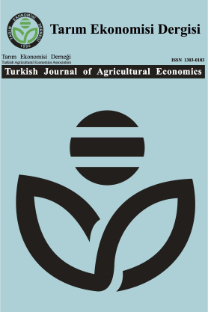TÜRKİYE'NİN DIŞ TİCARETİ VE ÇEVRE KİRLİLİĞİ: ÇEVRESEL KUZNETS EĞRİSİ YAKLAŞIMI
Bu çalışmada Türkiye'nin dış ticaretiyle çevre arasındaki etkileşim Çevresel Kuznets eğrisiyardımıyla zaman serisi verileri kullanılarak analiz edilmiştir. Çalışmada Türkiye'de kişibaşına düşen CO emisyonu ile kişi başına düşen milli gelir, ihracat ve ithalat verilerikullanılmıştır. Sonuçlar milli gelirin 1 birim (1$) artmasının kişi başına düşen CO2emisyonunu 2.69 kg. artırdığını göstermektedir. Ancak milli gelir daha da arttıkça buemisyon düzeyi azalmaktadır. Bu durum Türkiye'nin milli geliri ile emisyon hacmiarasındaki ilişkinin Çevresel Kuznets eğrisi ile uyumlu olduğunu göstermektedir. Diğeryandan ticaret açıklık indeksinin1 birim artması ise kişi başına azaltmasına rağmen istatistikiaçıdan önemsizdir. Bu durum Türkiye'nin üretim ve ihracat artışının kirliliği artırdığınıortaya koymakta ve Kirlilik Sığınağı Hipotezini doğrulamaktadır. Türkiye'de ulusal tarımpolitikaları içerisinde çiftçilerin ortak kullanılan kaynakların zarar görmesini önleyecekönlemlerin alınması, dış ticarette ise ihraç edilen ürünlerde çevreyi kirletmeyen ürünlerdeyoğunlaşmanın sağlanması, ithal edilen tarımsal ürünlerde sağlık ve çevreye uyumözellikleriyle ilgili standartların geliştirilip denetlenmesi gerekmektedir. Bu konuda ilerideyapılacak çalışmalar Çevresel Kuznets Eğrisi'ne etki eden diğer faktörleri (iklim, korumaoranları, standartlar vb.) içerecek şekilde geliştirilebilir
Anahtar Kelimeler:
Çevresel Kuznets Eğrisi, Kirlilik Sığınağı Hipotezi, Dış Ticaret, TarımTicareti, Türkiye
Turkey's Foreign Trade and Environmental Pollution: An Environmental Kuznets Curve Approach
This study examines the interaction between the foreign trade and environment employingthe Environmental Kuznets Curve (EKC) and utilizing time series data. The data related tothe CO emission per capita, GDP per capita, export, and import values were used in thestudy. The results show that CO emission per capita increases by 2.69 kg as GDP per capitaincrease 1 unit (1$). However, as GDPper capita increases further, the emission level starts todecrease. These findings confirm the EKC for Turkey. On the other hand, trade opennessindex increases the emission level per capita by 16.52 kg, while agricultural openness indexhas a negative impact on the level of emission although not significant. The findings alsoconfirm the Pollution Haven Hypothesis. It is necessary to take measures to safeguardcommon sources used by farmers. In terms of foreign trade, the measures that will lead tospecialization in less polluting sectors on export side, and designing and monitoring thesanitary and environmentally friendly standards on import side should be designed andmonitored. Future studies in this area may include other factors that impact EKC, such asclimate, protection levels, and standards
Keywords:
Environmental Kuznets Curve, Pollution Haven Hypothesis, Foreign Trade, Agricultural Trade, Turkey,
___
- Cole, M. A. 2003. “Development, Trade and Environment. How Robust is the E n v i r o n m e n t a l K u z n e t s C u r v e ? ” Environment and Development Economics 8, 557-580.
- Cole, M. A. 2004. “Trade, the Pollution Haven Hypothesis and the Environmental Kuznets Curve: Examining the Linkages”.
- Economics. 48 (1), 71-81.
- Desus, S., Bussulo, M. 1998. “Is There a Trade- off between Trade Liberalization and Pollution Abatement? A Computable General Equilibrium Assessment Applied to Costa Rica”, (1): 11- 31.
- : 20 Journal of Policy Modeling
- Grossman, G. M. and Krueger, A. B. 1991. Environmental Impact of a North American Free Trade Agreement. Working Paper 3914. NBER, Cambridge.
- Krissoff, B., Ballenger, N., Dunmore, J. and Gray, D. 1996. Exploring Linkages among Agriculture, Trade, and the Environment: Issues for the Next Century Agricultural Economics Report No. ERS, Washington, D.C.,AER 738 .
- Kumbaroglu, G. S. 2003.
- “Environmental Taxation and Environmental Effects: A CGE Analysis for Turkey”. Modeling Kuznets, S. 1955.
- “Economic Growth and Income inequality”,
- Review , 45(1), 1-28.
- Lankoski, J. 1997. Environmental Effects of Agricultural Trade Liberalization and Domestic Agricultural Policy Reforms, U N C T A D D i s c u s s i o n P a p e r s , UNCTAD/OSG/DP/126, Geneva.
- Lee, H. and Roland-Holst, D. 1997.
- “The Environment and Welfare Implications of Trade and Tax Policy.”
- Development Economics, 52, 65-82.
- Paudel, K. P., Zapata, H. and Susanto, D. 2005. “An Empirical Test of Environmental Kuznets Curve for Water Pollution”. Environmental& Resource Economics, 9:507-537.
- Saunders, C., Wreford, A., and Cagatay, S. 2006. “Trade Liberalization and Greenhouse Gas Emissions: The Case of Dairying in the European Union and New Zealand.”The Australian Journal of Agricultural and Resource Economics, 50, 538-555.
- Shafik, N. and Bandyopadhyay, S. 1992. “Economic Growth and Environmental Quality: Time Series and Cross Section Evidence”. World Bank Working Paper, WPS904, Washington D.C.
- Suri, V. and Chapman, D. 1998. “Economic Growth, Trade and Energy: Implications for the Environmental Kuznets Curve.” Ecological Economics, 25(2), 195-208.
- Torras, M. and Boyce, J. K. 1998. “Income Inequality and Pollution: A Reassessment of the Environmental Kuznets Curve”. Ecological Economics, 25 (2):147-160. UN Comtrade (2006.
- UN Commodity Trade S t a t i s t i c s
- Http://unstats.un.org/unsd/comtrade/
- D a t a b a s e . World Bank, World Development Indicators, CD, 2005.
- Yandle, B., Vijayaraghavan, M., and Bhattarai, M. 2007.
- Curve: A Primer. PERC Research Study, 02- 01. Property and Environment Research Center
- Http://www.perc.org/perc.php?id=688
- Yang, H-Y. 2001. “Trade Liberalization and Pollution:AGeneral EquilibriumAnalysis of Carbon Dioxide Emissions in Taiwan”. Economic Modeling,18 , 435-454.
- Journal of Policy American Economic Journal of : 13.08.2007 : 24.01.2008
- ISSN: 1303-0183
- Yayın Aralığı: Yılda 2 Sayı
- Başlangıç: 1992
- Yayıncı: Tarım Ekonomisi Dergisi
Sayıdaki Diğer Makaleler
TÜRKIYE VE AVRUPA BIRLIGINDE TARIMIN ÖRGÜTLENME DESENI VE TARIMSAL KOOPERATIFLER
GIDA ÜRÜNLERİ PİYASASINDA YENİ PAZARLAMA STRATEJİLERİ: İMALATÇI MARKALARA KARŞI ÖZEL MARKALAR
TÜRKİYE'DEKİ TARIM EKONOMİSİ BÖLÜMLERİNİN SIRALAMASI
SANLIURFA ILI’NDE KADINLARIN TARIMSALYAYIM ÇALISMASINDAN YARARLANMASINA ETKI EDEN OLUMSUZ ETKENLER
Hacer ÇELİK ATEŞ, Mustafa TERİN
TÜRKİYE'DE HAYVANSAL ÜRETİM VE HAYVANCILIK İŞLETMELERİNİN ÖZELLİKLERİ
TÜRKİYE'NİN DIŞ TİCARETİ VE ÇEVRE KİRLİLİĞİ: ÇEVRESEL KUZNETS EĞRİSİ YAKLAŞIMI
